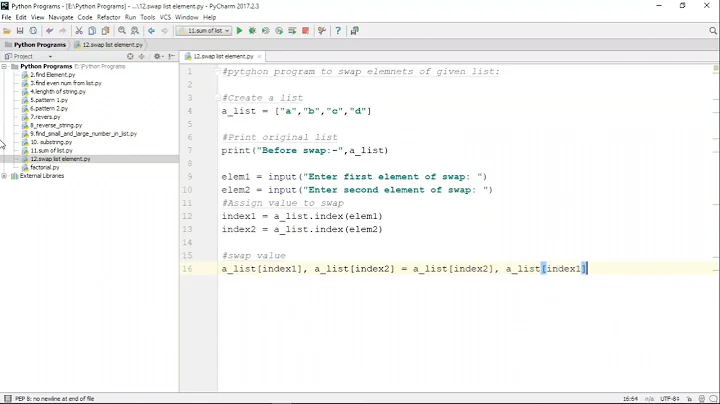Python swapping lists
Solution 1
Looks like Python internally swaps the items. Check this program
a, b = [1, 2], [2, 3]
def func():
a, b = b, a
import dis
dis.dis(func)
Output
4 0 LOAD_FAST 0 (b)
3 LOAD_FAST 1 (a)
6 ROT_TWO
7 STORE_FAST 1 (a)
10 STORE_FAST 0 (b)
13 LOAD_CONST 0 (None)
16 RETURN_VALUE
So, Python pushes references from b and a in the stack with LOAD_FAST. So, now the top most element is the reference pointed by a and the next one is the reference pointed by b. Then it uses ROT_TWO to swap the top two elements of the stack. So, now, the top most element is the reference pointed by b and the next one is the reference pointed by a and then assigns the top two elements of the stack to a and b respectively with STORE_FAST.
That's how sorting is happening in the assignment statement, when the number of items we deal with is lesser than 4.
If the number of items is greater than or equal to four, it builds a tuple and unpacks the values. Check this program
a, b, c, d = [1, 2], [2, 3], [4, 5], [5, 6]
def func():
a, b, c, d = d, c, b, a
import dis
dis.dis(func)
Output
4 0 LOAD_FAST 0 (d)
3 LOAD_FAST 1 (c)
6 LOAD_FAST 2 (b)
9 LOAD_FAST 3 (a)
12 BUILD_TUPLE 4
15 UNPACK_SEQUENCE 4
18 STORE_FAST 3 (a)
21 STORE_FAST 2 (b)
24 STORE_FAST 1 (c)
27 STORE_FAST 0 (d)
30 LOAD_CONST 0 (None)
33 RETURN_VALUE
Solution 2
Because Python assignment first evaluates the right-hand-side expression, then applies the result to the left-hand-side targets.
So, first, Python creates (<reference to list b>, <reference to list a>) as a tuple, then assigns the first item in that tuple to a, and the second item in that tuple to b. This swaps the references around neatly.
You could expand the assignment to read it like this:
tmp = b, a
a = tmp[0]
b = tmp[1]
Related videos on Youtube
Aswin Murugesh
Head of Engineering at Ongil Pvt Ltd contact me : facebook Twitter mail: [email protected]
Updated on October 20, 2022Comments
-
 Aswin Murugesh 9 months
Aswin Murugesh 9 monthsIn python, when I assign a list to another, like:
a = [1,2,3] b = aNow b and a point to the same list. Now considering two lists,
a = [1,2,3] b = [4,5,6] a,b = b,aNow how is it that they are swapped like any other data type and does not end up both pointing to the same list?
-
 thefourtheye over 9 yearsLooks like Python doesn't create a tuple here. Please check my answer.
thefourtheye over 9 yearsLooks like Python doesn't create a tuple here. Please check my answer. -
 Martijn Pieters over 9 yearsNo, because the assignment is optimised.
Martijn Pieters over 9 yearsNo, because the assignment is optimised. -
 Martijn Pieters over 9 yearsThat comment went out a little too early (on my mobile). The assignment is optimised; the compiler skips creating a tuple when multiple assignment is used. There is no point. But for understanding what happens imagining it is a tuple is fine. In the expanded assignment example
Martijn Pieters over 9 yearsThat comment went out a little too early (on my mobile). The assignment is optimised; the compiler skips creating a tuple when multiple assignment is used. There is no point. But for understanding what happens imagining it is a tuple is fine. In the expanded assignment exampletmpis a tuple. -
 thefourtheye over 9 yearsYup. That was my initial understanding. Even my first edit had that tuple based answer only. I simply tried
thefourtheye over 9 yearsYup. That was my initial understanding. Even my first edit had that tuple based answer only. I simply trieddisand got surprised. :) -
 thefourtheye over 9 years@MartijnPieters That's why I had to make
thefourtheye over 9 years@MartijnPieters That's why I had to makereferencesin bold. -
 thefourtheye over 9 years@MartijnPieters Got you :) Please check my updated answer, including the tuple unpacking stuff.
thefourtheye over 9 years@MartijnPieters Got you :) Please check my updated answer, including the tuple unpacking stuff. -
 Martijn Pieters over 9 yearsAs for the optimisation I talked about; it is indeed limited to two and three item unpacks; see
Martijn Pieters over 9 yearsAs for the optimisation I talked about; it is indeed limited to two and three item unpacks; seepeephole.cif you are interested. For two items,BUILD_TUPLEandUNPACK_SEQUENCEis replaced byROT_TWO, for three items it is replaced byROT_THREEthenROT_TWO. Because 4 items would require three opcodes (ROT_FOUR, thenROT_THREEthenROT_TWO) it is no longer worth optimizing for. -
 thefourtheye over 9 years@MartijnPieters Good that you read this. :) Otherwise this answer would have been misleading. Updated that sentence. Please check now
thefourtheye over 9 years@MartijnPieters Good that you read this. :) Otherwise this answer would have been misleading. Updated that sentence. Please check now -
 Steve Jessop over 9 yearsI think it's pretty much optional whether you think of the LHS of the assignment as being a tuple, or as being a grammar production consisting of a comma-separated list of entities (which themselves may be such lists). Of course it's both, but in general when a comma-separated list of sub-expressions is evaluated for its result a tuple is created. When that same grammar production (called
Steve Jessop over 9 yearsI think it's pretty much optional whether you think of the LHS of the assignment as being a tuple, or as being a grammar production consisting of a comma-separated list of entities (which themselves may be such lists). Of course it's both, but in general when a comma-separated list of sub-expressions is evaluated for its result a tuple is created. When that same grammar production (calledtestlistin the formal Python grammar) is assigned to, one isn't. -
 Martijn Pieters over 9 years@SteveJessop: the compiler produces a
Martijn Pieters over 9 years@SteveJessop: the compiler produces aBUILD_TUPLEopcode in both cases, but the peephole optimizer then replaces that opcode withROT_opcodes when there is an assignment on the LHS and only 3 or 2 values are involved. For more elements, tuples are still actually created. -
 Steve Jessop over 9 years@MartijnPieters: ah, thanks. I didn't realise this was a special case. @Aswin: I think it's also instructive to work through why
Steve Jessop over 9 years@MartijnPieters: ah, thanks. I didn't realise this was a special case. @Aswin: I think it's also instructive to work through whya[:], b[:] = b, adoesn't swap the contents of the lists -- once it's obvious to you why not, and also obvious whya, b = b, adoes swap the references, then you probably understand how the unpacking and assignment works :-)






